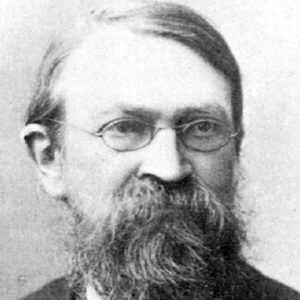Ernst Waldfried Josef Wenzel Mach was a renowned philosopher and physicist from Austria. He is internationally recognized for his contributions to physics, philosophy, and physiological psychology. He was the first physicist to explore supersonic motion, which resulted in his name becoming a standard for supersonic speed measurement. His work is credited with advancing our understanding of the Doppler Effect. Among his most significant contributions were his examination and final rejection of Isaac Newton’s concept of time and space, which inspired Albert Einstein and his theory of relativity. In philosophy, his opinions and observations laid the groundwork for concepts such as logical positivism and American pragmatism. His most well-known philosophical contribution is his effect on the Vienna Circle (the pre-Vienna Circle organization was called the ‘Ernst Mach Verein’). Some of his influences are being re-examined because they are more complicated and delicate than they were previously perceived to be. He was also a noted historian of science and chaired the University of Vienna’s Department of Philosophy of the Inductive Sciences. Due to his deliberate rejection of conservative viewpoints in philosophy and physics, his positivist-empiricist views affected subsequent generations.
Childhood & Adolescence
Ernst Mach was the eldest child of Johann Mach and Josephine Lanhaus. He was born in Chirlitz-Turas, Moravia, on February 18, 1838. (now Brno, Czech Republic).
When he was two years old, his family relocated to a farmhouse outside Vienna, where he continued his studies until the age of fourteen. His father’s superior education and his mother’s artistic disposition molded his understanding in both philosophical and scientific directions.
Following his home education, he enrolled at a Gymnasium in Krom, where he studied for the following three years. In 1855, he enrolled as a student at the ‘University of Vienna,’ where he spent a year studying physics and medical physiology.
He received a degree in physics in 1860 for his thesis on electrical charge and induction. The next year, he also obtained his Habilitation.
Ernst Mach’s Career
Mach worked as a Privatdozent in Andreas von Ettinghausen’s laboratory from 1860 until 1862. He spent years there doing optics and acoustics studies and also began a systematic investigation of the Doppler Effect.
He continued to teach at the ‘University of Vienna,’ and earned the majority of his income by presenting sought-after lectures on psychophysics, optics, and musical acoustics.
He was appointed professor of mathematics at ‘Graz University in 1864. He was also made a professor of physics after two years.
He left Graz in 1867 to become a professor of experimental physics at Prague’s ‘Karls-Universität,’ where he remained for over three decades. He did research at Prague on retinal stimuli, auditory perception, and wave motion, as well as the propagation of sound waves using photographic devices, which resulted in the words ‘Mach Number’ and ‘Mach Angle’.
He hypothesized and experimentally demonstrated the existence of shock waves in the shape of a cone with the projectile at the tip.
His research ‘on the influence of light stimulus spatial dispersion on the retina’ resulted in the discovery of what are now known as ‘Mach Bands.’
During his stay in Prague, the eminent physicist was an outspoken opponent of academic segregation. Nonetheless, segregation occurred, and he was appointed head of the University’s German division.
He was invited to Vienna in 1895, where he chaired the newly founded department of inductive science theory. A year later, he published ‘Principien der Wärmelehre’ (‘Thermodynamic Principles’).
He suffered a stroke in 1898 while serving as Dean of Philosophy in Vienna, paralyzing the right half of his body. Three years later, he announced his retirement and ceased any further research.
Despite his failing health, he continued to teach and published ‘Erkenntnis und Irrtum’ (‘Knowledge and Error’) in 1905, followed by his autobiography five years later.
His Significant Works
One of the most well-known concepts advanced by the revolutionary physicist is referred to be ‘Mach’s Principle,’ which dealt with the fundamental origins of inertia, yet he never recorded it. It was delivered in a spoken visual format, which Philipp Frank attributes to Mach.
His most influential publication, ‘The Science of Mechanics: A Critical and Historical Account of Its Development,’ is considered to have affected the ideas of countless aspiring scientists over time. Albert Einstein cited Mach’s influence as the reason he shifted his perspective on physics.
Personal History and Legacies
Ernst Mach married Ludovica Marussig in Graz in 1867. Later in life, they had five children – four sons and a daughter.
Ludwig Mach, his son, was a close collaborator, supporting him in studies undertaken throughout his term in Prague. Mach and Ludwig captured images of the shadows cast by the invisible shock waves.
After having a paralyzing stroke, the physicist relocated to Vaterstetten, near Munich, to be near his son Ludwig. Mach died of heart illness on February 19th, 1916, and was buried in the Haar cemetery.
The Austrian Federal Ministry of Science, Research, and Economy funds the ‘Ernst Mach Grants in his honor to encourage international scholars to pursue academic careers in Austria.
He is widely regarded as the founder of the area of Science Philosophy.
Estimated Net worth
Ernst is one of the wealthiest physicists and is placed on the list of the most popular physicists. Ernst Mach’s net worth is estimated to be at $5 million, based on our review of Wikipedia, Forbes, and Business Insider.
Trivia
While Ernst Mach was a lecturer at the ‘University of Graz,’ he met Emanuel Herrmann, who in 1869 invented the postcard.
He chastised Max Planck for his method of establishing the existence of atoms, which he deemed incompatible with physics.


